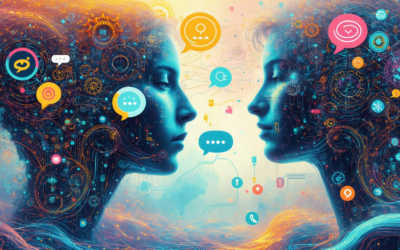Key Takeaways
- Voice Bots Revolutionize Communication: These AI-driven tools enhance user interactions by providing real-time, human-like responses, bridging the gap between technology and customer service.
- Natural Language Processing (NLP): Voice bots utilize advanced NLP to understand user intent, enabling them to handle complex inquiries effectively and improve customer satisfaction.
- 24/7 Availability: Unlike human agents, voice bots operate around the clock, ensuring users receive assistance at any time, boosting operational efficiency.
- Legal Compliance is Key: Understanding the legal landscape surrounding voice bot usage is crucial for businesses to avoid illicit activities and protect user data.
- Future Trends: The integration of voice bots with IoT devices and multi-channel communication will shape the future of customer service, making interactions more seamless.
In today’s fast-paced digital landscape, voice bots are revolutionizing the way we communicate, bridging the gap between technology and human interaction. This article delves into the fascinating world of voice bots, exploring their fundamental characteristics, the role of AI in enhancing their capabilities, and the legal considerations surrounding their use. We will also address common questions, such as whether popular assistants like Siri qualify as voice bots, and how to identify these innovative tools in everyday communication. Furthermore, we will differentiate between voice bots and audio bots, highlighting their unique applications across various industries. As we navigate through the benefits of voice bots in customer service and examine the future of voice bot technology, you’ll gain valuable insights into how these AI-driven solutions are shaping our communication landscape today. Join us as we uncover the potential of voice bots AI and their impact on enhancing user experiences.
Understanding the Basics of Voice Bots
A voice bot is an advanced form of artificial intelligence (AI) software designed to facilitate interactions in various applications, particularly within contact centers. Utilizing natural language processing (NLP) and machine learning algorithms, voice bots can effectively capture, interpret, and analyze vocal inputs from users. They respond in real-time with human-like voice outputs, enhancing user experience and operational efficiency.
Key Features of Voice Bots
- Natural Language Understanding (NLU): Voice bots leverage NLU to comprehend user intent and context, allowing for more accurate responses. This capability is crucial for handling complex queries and providing relevant information.
- Conversational AI: By employing machine learning, voice bots continuously improve their conversational abilities, learning from past interactions to enhance future responses. This adaptability makes them more effective over time.
- Integration with Other Systems: Voice bots can be integrated with various platforms, including customer relationship management (CRM) systems and messaging applications, to streamline workflows and provide seamless user experiences.
- 24/7 Availability: Unlike human agents, voice bots can operate around the clock, ensuring that users receive assistance at any time, which is particularly beneficial for businesses with global clientele.
- Cost Efficiency: Implementing voice bots can significantly reduce operational costs for businesses by automating routine inquiries and freeing up human agents to focus on more complex tasks.
Recent studies indicate that the use of voice bots can lead to improved customer satisfaction and engagement, as they provide quick and accurate responses to user inquiries (Source: McKinsey & Company). Furthermore, as voice technology continues to evolve, the integration of voice bots with platforms like Messenger Bot can enhance their functionality, allowing for multi-channel interactions that cater to user preferences (Source: Gartner).
The Role of AI in Voice Bots
AI plays a pivotal role in the functionality and effectiveness of voice bots. By harnessing advanced algorithms, voice bots can analyze vast amounts of data to improve their interactions. This includes understanding user sentiment, predicting user needs, and providing personalized responses that enhance the overall user experience.
Moreover, AI-driven voice bots can adapt to various languages and dialects, making them versatile tools for global communication. This multilingual capability ensures that businesses can cater to diverse audiences, thereby expanding their reach and improving customer satisfaction.
As AI technology continues to advance, the potential applications of voice bots are expanding. For instance, integrating voice bots with platforms such as Brain Pod AI can lead to even more sophisticated interactions, allowing for seamless transitions between voice and text-based communication.

Is Using Bots Illegal?
The legality of using voice bots largely depends on their application and the context in which they are employed. Here’s a comprehensive overview:
- Definition of Bots: Bots are automated software applications designed to perform specific tasks, often at a much faster rate than humans. They can be used for various purposes, including data scraping, customer service, and social media management.
- Legal Uses of Bots:
- Customer Support: Many businesses utilize bots, such as Messenger Bots, to enhance customer service by providing instant responses to inquiries. This use is generally legal and can improve user experience.
- Data Analysis: Bots can be employed for legitimate data collection and analysis, aiding businesses in making informed decisions.
- Illegal Uses of Bots:
- Fraudulent Activities: It is illegal to use bots for activities such as spamming, phishing, or scraping personal data without consent. These actions violate laws like the Computer Fraud and Abuse Act (CFAA) in the United States.
- Market Manipulation: Bots used to manipulate stock prices or engage in unfair trading practices are also illegal and can lead to severe penalties.
- Regulatory Considerations: Different jurisdictions have varying laws regarding bot usage. For instance, the European Union’s General Data Protection Regulation (GDPR) imposes strict guidelines on data collection and user consent, impacting how bots can operate.
- Best Practices: To ensure compliance, businesses should:
- Clearly disclose the use of bots to users.
- Obtain necessary permissions for data collection.
- Regularly review and update their practices in line with evolving regulations.
In conclusion, while bots themselves are not illegal, their usage must adhere to legal standards to avoid engaging in illicit activities. For further reading, consult resources such as the Electronic Frontier Foundation (EFF) and legal analyses from reputable law firms specializing in technology law.
Legal Considerations Surrounding Voice Bots
When discussing voice bots, it’s essential to consider the legal implications surrounding their use. As businesses increasingly adopt AI voice bots for customer interactions, understanding the legal landscape becomes crucial. Compliance with regulations such as the GDPR is vital for ensuring that user data is handled responsibly. This includes obtaining explicit consent for data collection and providing users with clear information about how their data will be used. Additionally, businesses should implement robust security measures to protect user information from unauthorized access.
Compliance and Regulations for Voice Bots
Compliance with regulations is a significant aspect of deploying voice bots. Organizations must stay informed about the evolving legal frameworks that govern bot usage. For instance, the voice newspaper industry must adhere to specific guidelines to ensure that their voice chat bots operate within legal boundaries. This includes ensuring that the bots do not engage in deceptive practices and that they respect user privacy. Regular audits and updates to compliance strategies can help mitigate legal risks associated with the use of AI voice bots.
How can I tell if I’m talking to a bot?
Identifying whether you’re conversing with a bot can enhance your communication experience. Here are some key indicators to help you determine if you’re interacting with a voice bot:
- Response Time: Bots typically respond almost instantaneously, while human responses may take longer as they formulate their replies.
- Generic Responses: If the answers lack personalization or empathy, it is likely a bot. Humans tend to provide more nuanced and context-aware responses.
- Repetitive Patterns: Bots often use pre-written scripts, leading to repetitive phrases or answers. If you notice the same responses to different questions, it may indicate a bot.
- Complexity of Questions: Test the conversation by asking open-ended or complex questions. Bots may struggle to provide coherent answers to nuanced inquiries.
- Emotional Engagement: Humans can express emotions and understand subtleties in conversation. If the interaction feels flat or devoid of emotional depth, it could be a bot.
- Context Awareness: Bots may fail to maintain context over multiple exchanges. If the conversation seems disjointed or lacks continuity, it is likely a bot.
- Use of Language: Pay attention to the language used. Bots may have a more formal or robotic tone, while humans often use colloquial language and slang.
For further insights into distinguishing between bots and humans, you can refer to studies on conversational AI and user experience, such as those published by the Association for Computing Machinery (ACM) and the Journal of Human-Computer Interaction.
Common Features of Voice Bots
Voice bots, including AI voice chatbots, come equipped with several features that enhance user interaction and streamline communication. Here are some common characteristics:
- Natural Language Processing (NLP): Voice bots utilize NLP to understand and process user queries, allowing for more human-like interactions.
- Voice Recognition: These bots can recognize and respond to voice commands, making them accessible and user-friendly.
- Integration Capabilities: Voice bots can integrate with various platforms, such as social media and customer service systems, to provide seamless communication.
- Personalization: Advanced voice bots can learn from user interactions, tailoring responses based on previous conversations and preferences.
- Multilingual Support: Many voice bots offer support for multiple languages, catering to a diverse user base.
By understanding these features, users can better appreciate the capabilities of voice bots and how they enhance communication in various contexts.
Voice Bots AI: The Future of Communication
As we delve into the future of communication, voice bots are at the forefront of innovation, transforming how we interact with technology. These AI-driven solutions are not just tools; they are becoming integral to our daily lives, enhancing user experiences across various platforms. The advancements in voice bots AI are paving the way for more intuitive and efficient communication methods.
Innovations in Voice Bot Technology
Voice bots are evolving rapidly, thanks to continuous innovations in artificial intelligence. Here are some key advancements shaping the future of voice bots:
- Enhanced Natural Language Processing (NLP): Modern voice bots utilize advanced NLP techniques to understand context and nuances in human speech. This capability allows for more natural interactions, making conversations with voice bots feel less robotic and more human-like.
- Multi-Modal Interaction: The integration of voice bots with visual interfaces is becoming common. Users can now interact with voice bots through voice commands while receiving visual feedback, enhancing the overall user experience.
- Personalization: Voice bots are increasingly capable of learning user preferences and adapting their responses accordingly. This personalization leads to more relevant interactions, improving user satisfaction.
- Integration with IoT Devices: Voice bots are being integrated into smart home devices, allowing users to control their environments through voice commands. This trend is making everyday tasks more convenient and efficient.
The Impact of AI on Voice Bot Development
The impact of AI on voice bot development cannot be overstated. AI technologies are enabling voice bots to perform complex tasks that were once thought to be exclusive to human agents. Here are some significant impacts:
- Improved Accuracy: AI algorithms are enhancing the accuracy of voice recognition and response generation, reducing misunderstandings and improving user trust in voice bots.
- Scalability: Businesses can deploy voice bots at scale, handling thousands of interactions simultaneously without compromising service quality. This scalability is crucial for customer service applications.
- Cost Efficiency: By automating routine inquiries and tasks, voice bots help businesses reduce operational costs while maintaining high levels of customer engagement.
- Continuous Learning: AI-powered voice bots can learn from interactions, continuously improving their performance and adapting to new user needs over time.
As we look ahead, the role of voice bots AI in communication will only grow, making it essential for businesses to embrace these technologies to stay competitive. For more insights on how AI is transforming user interactions, explore our article on voice-based chatbots.

Voice Bots AI: The Future of Communication
As we delve into the realm of voice bots, it’s essential to recognize the innovations that are shaping their future. The integration of artificial intelligence (AI) into voice bots is revolutionizing how we communicate, making interactions more seamless and efficient. This section explores the latest advancements in voice bot technology and the profound impact AI has on their development.
Innovations in Voice Bot Technology
Recent advancements in voice bots AI have led to significant improvements in functionality and user experience. Key innovations include:
- Natural Language Processing (NLP): Enhanced NLP capabilities allow voice bots to understand and respond to user queries more accurately. This technology enables voice chat bots to engage in more natural conversations, mimicking human-like interactions.
- Machine Learning: Voice bots are increasingly utilizing machine learning algorithms to learn from user interactions. This adaptability allows them to improve responses and personalize user experiences over time.
- Multilingual Support: With the rise of global communication, many voice bots now offer multilingual capabilities, enabling them to cater to diverse audiences. This feature is particularly beneficial for businesses looking to expand their reach.
- Integration with IoT Devices: Voice bots are becoming integral to the Internet of Things (IoT), allowing users to control smart devices through voice commands. This integration enhances convenience and accessibility for users.
The Impact of AI on Voice Bot Development
The role of AI in the evolution of voice bots cannot be overstated. AI technologies are driving improvements in several areas:
- Enhanced User Engagement: AI-powered voice bots can analyze user behavior and preferences, leading to more engaging and tailored interactions. This capability is crucial for businesses aiming to improve customer service through voice bots.
- Cost Efficiency: By automating responses and interactions, businesses can significantly reduce operational costs. AI voice bots streamline processes, allowing human agents to focus on more complex tasks.
- Data-Driven Insights: AI enables voice bots to gather and analyze data from user interactions, providing valuable insights into customer preferences and behavior. This information can inform marketing strategies and product development.
As we continue to explore the potential of voice bots, it’s clear that the integration of AI will play a pivotal role in shaping the future of communication. For further insights into how AI is transforming user interactions, check out our article on voice-based chatbots.
Voice Bots in Customer Service: Enhancing User Experience
Voice bots have revolutionized customer service by providing efficient, automated solutions that enhance user experience. These AI-driven tools are designed to handle customer inquiries, process requests, and deliver information seamlessly, making them invaluable in today’s fast-paced digital landscape.
Case Studies of Successful Voice Bot Implementations
Numerous companies have successfully integrated voice bots into their customer service strategies, showcasing the effectiveness of this technology. For instance, a leading telecommunications provider implemented a voice bot to manage customer inquiries related to billing and technical support. This resulted in a 30% reduction in call wait times and a significant increase in customer satisfaction ratings.
Another example is a major airline that deployed a voice bot to assist with flight bookings and cancellations. By automating these processes, the airline not only improved operational efficiency but also enhanced the overall customer experience, allowing human agents to focus on more complex issues. These case studies highlight how voice bots can streamline operations and improve customer interactions.
Future Trends in Customer Service Voice Bots
The future of voice bots in customer service looks promising, with several trends emerging that will shape their development. One significant trend is the increasing use of AI voice bots that leverage natural language processing (NLP) to understand and respond to customer inquiries more effectively. This advancement will lead to more human-like interactions, making customers feel more valued and understood.
Additionally, the integration of voice bots with other communication channels, such as messaging apps and social media platforms, will enhance their accessibility. For example, integrating voice bots with platforms like Discord can provide users with a seamless experience across different mediums. As businesses continue to adopt these technologies, we can expect voice bots to play a pivotal role in transforming customer service into a more efficient and engaging process.
Voice bots in customer service: Enhancing User Experience
Voice bots have revolutionized customer service by providing efficient, automated solutions that enhance user experience. These AI-driven tools can handle a variety of tasks, from answering frequently asked questions to guiding users through complex processes. By integrating voice bots into customer service strategies, businesses can significantly improve response times and customer satisfaction.
Case Studies of Successful Voice Bot Implementations
Numerous companies have successfully integrated voice bots into their customer service frameworks, showcasing the effectiveness of this technology. For instance, a leading telecommunications provider implemented a voice bot to manage customer inquiries related to billing and technical support. This resulted in a 30% reduction in call volume to human agents, allowing them to focus on more complex issues. Additionally, a major airline utilized a voice bot to assist customers with flight bookings and cancellations, which led to a 25% increase in customer satisfaction ratings.
These case studies illustrate how voice bots can streamline operations and enhance the overall customer experience. By automating routine tasks, businesses can allocate resources more effectively and ensure that customers receive timely assistance.
Future Trends in Customer Service Voice Bots
The future of voice bots in customer service looks promising, with several trends emerging that will shape their development. One significant trend is the integration of advanced AI technologies, such as natural language processing (NLP), which allows voice bots to understand and respond to customer inquiries more accurately. This advancement will lead to more personalized interactions, as voice bots can learn from previous conversations and adapt their responses accordingly.
Another trend is the increasing use of multilingual support in voice bots, enabling businesses to cater to diverse customer bases. As companies expand globally, the ability to communicate in multiple languages will become essential for effective customer service. Furthermore, the rise of omnichannel support will see voice bots seamlessly integrate with other communication channels, such as chatbots and social media platforms, providing a cohesive customer experience.
In conclusion, the integration of voice bots in customer service not only enhances user experience but also positions businesses to adapt to future trends in technology and customer expectations. For more insights on how AI is transforming customer interactions, explore our article on voice-based chatbots.





